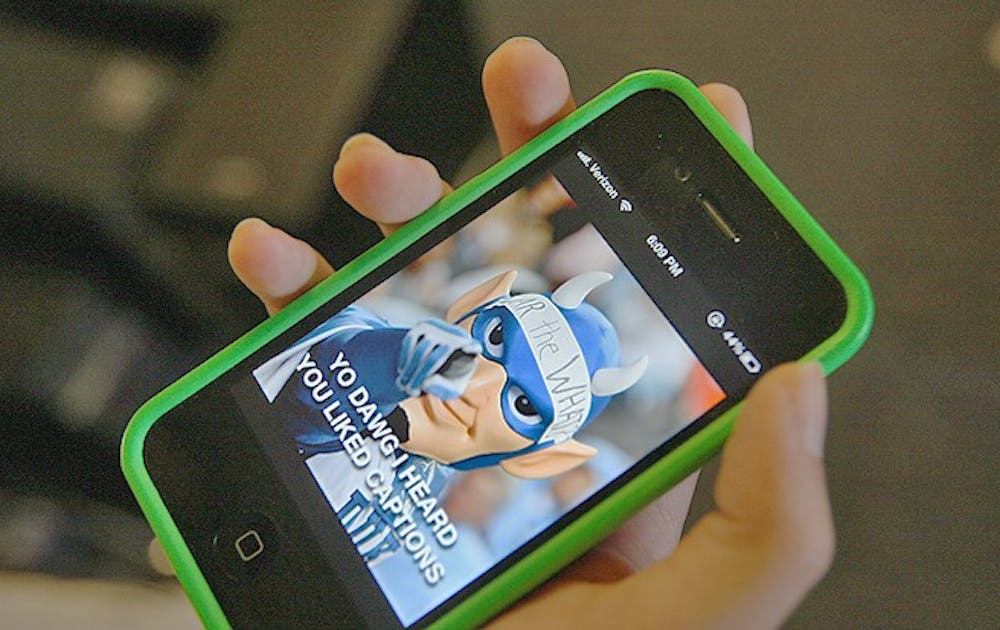Perched at number six on the top free mobile applications chart in Apple’s iTunes Store as of Wednesday, “I’d Cap That” has stirred a sensation among iPhone users.
Within the past month, the app has grabbed the spotlight by making a presence on national charts. It had the top trending Twitter hashtag—a label used to categorize posts—and it recently ranked as the photo and video app with the most downloads. “I’d Cap That” lets a user personalize their iPhone photo library by assigning captions on individual photos. Random comments are generated by the application, and the final product is then ready to be posted on various social media sites or sent to friends and family, said app creator Cody Kolodziejzyk, Trinity ’12.
“I’d Cap That” was fueled by Kolodziejzyk’s personal goal of improving his iPhone programming knowledge during his time at Duke. A computer science major and captain of the men’s swimming and diving team, Kolodziejzyk said he created the app in approximately two weeks over spring break. He worked on the coding and debugging in the evenings while competing at the NCAA Zone Diving Championships.
“I was compelled by the idea of coming up with hundreds of hilariously crude captions and giving the app out to my friends so we could all have a good laugh,” Kolodziejzyk wrote in an email Wednesday.
Several factors have led to the sudden popularity of the app, said James Martin, who writes the blog “Martin on Mobile Apps” for CIO.com—a media outlet serving chief information officers and other information technology leaders.
Martin noted, however, that a bulk of the app’s success was due to the function it serves in social settings.
“Once you select a photo, the fun begins because you have no idea what funny, crude, lewd, politically incorrect or downright knuckleheaded caption the app will add to your pictures,” Martin said. “I could imagine people at a party having a lot of fun with this app.”
Kolodziejzyk also said he believes that it is the “raw and dry” nature of the app that has captured the attention of so many young people, noting that the younger demographic is much more willing to share their user-generated content and experiment with new social networks.
“I started [the application] with my friend group in mind, but I later realized that the offensive and shocking nature of the app really appealed to people [who] are a few years younger than me,” he said.
The app has also had a large impact within the University, with several students noting its simplicity.
“With technology becoming increasingly complicated, it’s easy to get lost,” sophomore Clair Hong said. “It’s nice that it’s basically accessible to anyone who has a smartphone.”
In a society that highly values speed and efficiency, Kolodziejzyk said, it was important to eliminate user friction and intermediate processes when it came to sharing the photos created using the app.
He noted that the integration of Twitter greatly facilitated the sharing component of the “I’d Cap That” phenomenon.
“[Implementing Twitter connection] allowed the user to share content with minimal intrusion on their user experience,” he said. “As a result, the ‘capped’ photos went totally viral, and the app shot up to the top of the charts in a few days.”
Kolodziejzyk declined to comment on the financial aspects of the mobile app or the revenue generated by it.
He said he hopes to fulfill his passion and continue working in the mobile industry, noting that he will be working in the Silicon Valley in the coming year.
After using concepts learned in his classes, Kolodziejzyk hopes his success with the app will prompt other students to follow up on their own personal projects.
“I could have easily chosen not to bother with this, but ultimately I realized that I wouldn’t lose anything from trying,” he said. “Not only did the app hit number one, but I’ve learned so many valuable things about the app industry along the way.”
Get The Chronicle straight to your inbox
Signup for our weekly newsletter. Cancel at any time.

